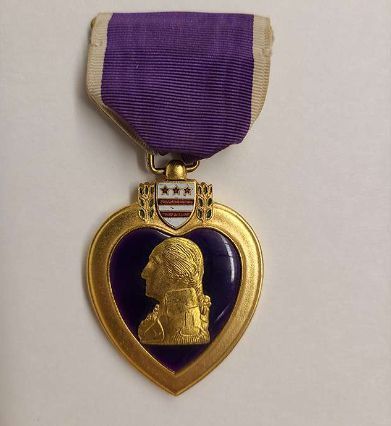Name/Title
USS Texas Purple Heart [Medal]Description
The Purple Heart is awarded in the name of the president of the United States to any member of the Armed Forces of the United States who has been wounded or killed. The citation reads:
UNITED STATES PACIFIC FLEET
COMMANDER BATTLESHIP
DIVISION FIVE
In the name of the President and by direction of the Secretary of the Navy, Commander Battleship Division FIVE, Rear Admiral P. K. Fischler, U.S. Navy, U.S. Pacific Fleet, awards the Order of the Purple Heart to
HENRY DANIEL JAHNKE, 610 28 07,
Aviation Machinist’s Mate First Class, United States Naval Reserve for wounds suffered while in action against the enemy over Okinawa on the 27th day of April 1945.Context
Battleship Texas was equipped with a staggering number of anti-aircraft guns. With ten 3″/50 caliber guns, ten quad 40 mm Bofors, and forty-four 20 mm Oerlikons, even an old battleship like Texas was an intimidating target for an enemy pilot. Over those 50 days at Okinawa, Texas fired nearly 6,000 rounds of anti-aircraft ammunition and made it through without a scratch on her. Texas had set a record for days at battle stations and won her last battle.
Okinawa was Texas’ final major battle and by far the hardest. Having seen the damage inflicted on other ships by Japanese air raids at Iwo Jima, Captain Baker made the decision to order the entire crew to remain at their battle stations for the duration of the battle, over 50 consecutive days. Men would sleep when and where they could, not returning to their bunks. Food was delivered to the men at their battle stations and was mostly K Rations, an early predecessor to modern MREs.
“We kind of felt irritated towards our captain, Charles A. Baker, who kept us in [battle stations] for all that time. As it turns out, he was doing the very thing he was supposed to do because some of the other ships, for instance the battleship Tennessee was a few hundred yards to our port, I could see it real good. One morning about dawn we got word that they were coming. So [on the Tennessee about] two-thirds of the crew had gone below. So when they sounded general quarters you could hear that “Bong, bong,” I could hear it from their ship all the way over to us. You could see them running just like monkeys trying to get to their battle stations. In the meantime one of those Japanese kamikazes hit them on a quad-forty gun mount just like the one that I was on.”
–RALPH FLETCHER, USMC
BATTLESHIP TEXAS CREW MEMBER
On April 6, Japanese forces launched the first of a series of kamikaze attacks as part of Operation Ten-Go, the last Japanese naval operation of the war. Between April 6 and June 22 ten attacks were launched, with a total of 1,465 kamikazes and over 1,300 other Japanese aircraft. The crew of Texas, always at the ready, fended off numerous attacks. On April 16, heavy aerial attacks began in the morning. It was the third Japanese attack, and this time Texas came under direct attack. With the crew at battle stations, Texas quickly responded, shooting a “Kate” bomber down only 1,800 yards from the ship. The attacks continued, and the crew stayed vigilant until retiring from the operational area on May 14. It was during this fighting that Aviation Machinist’s Mate First Class Henry Daniel Jahnke was wounded.
